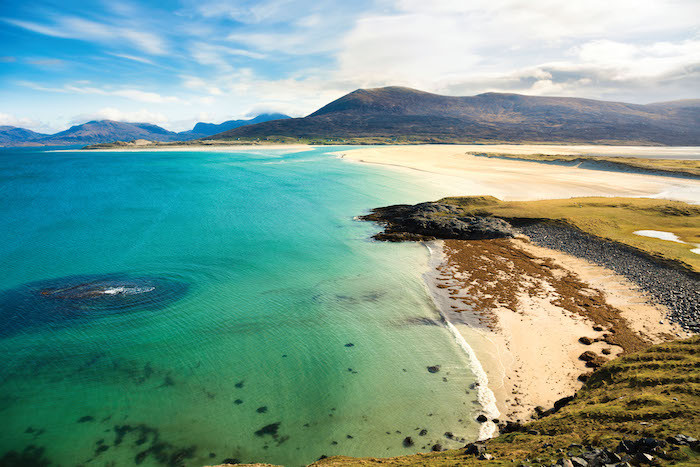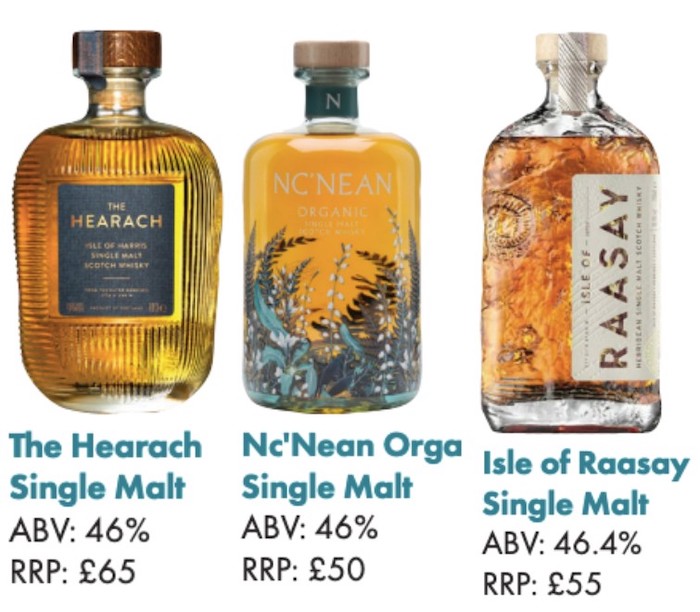
Across Scotland’s remote islands, distillers are reviving communities as they create new, terroir-driven whiskies. Dave Broom investigates this new movement of young producers.
It was one of those days when Harris could pass for Barbados. Sitting beside the Eilean Glas lighthouse, on Scalplay, connected to Harris by a bridge, we looked over to the north end of Skye. Earlier in the day, we’d wandered over white sands of the west coast. That night in the Harris distillery there would be a cèilidh: people singing, telling stories. The year before, I’d been on Raasay for a party, the place rammed with whisky-makers and locals. It had reminded me of a visit to Torabhaig on Skye, staying at the Eilean Iarmain hotel when the bar was taken over by music students from Sabhal Mòr Ostaig, the Gaelic university. What has this to do with the New Hebridean whisky? Everything.
Until recently, with the exception of distillery festooned Islay, there have been slim pickings across the Hebrides and the peninsulas of the west coast. There are many reasons for this scarcity, but at their heart is a 200-year-long lack of investment. If there are only a few jobs and no careers then there is no future for younger people. The result is an ageing population and a heavy reliance on the holiday season.
What the New Hebridean distillers have done is rethink the role of the distillery. Making whisky offers a career. Having a visitor centre creates more jobs. More visitors means that the hotels benefit. “It means,” says Annabel Thomas, owner of Nc’Nean on the Morvern peninsula, “that the school stays open, that the doctor’s surgery is retained.”
A distillery as a social enterprise was the founding principle behind Isle of Harris. With the island’s population halving over 50 years, musicologist and philanthropist Anderson ‘Burr’ Bakewell saw a distillery as a way to stem the outward flow of young people, giving them a reason to stay. Opened in 2015, it now employs 40 permanent staff.
In 2017, Raasay (a 20-minute ferry ride from Skye) was home to an ageing population of 150 people. Now, the distillery employs 30 people, with an average age of under 30. The island is alive again. At a time when technology means that a distillery could be run by one person in front of a computer screen, all of the New Hebrideans have increased the number of distillers, Raasay, Nc’nean and Harris all bottle on site. More jobs.
All are finding new ways to create whiskies which reflect their place. Nc’Nean is not only remote, but decided to only use organic barley. There’s long fermentations (68-114 hours), two styles of yeast, slow distillation and high cut points.
“The organic isn’t about vanity or just a selling point,” says Thomas. “The contribution that organic barley makes to the texture and mouthfeel of our whisky is key.” Two styles are made: ‘young’, fresh and immediate, for earlier releases, and the weightier ‘old’, which will sit in cask for longer.

It and Ardnamurchan are both powered by woodchip boilers, fuelled by trees from their respective estates. Stylistically they are different, Ardnamurchan fitting into the oily, robust west coast whiskies from Campbeltown and Fort William. Unpeated and peated new-make are aged separately, before being blended. There is heft and oils but also a slinky, lightly smoked elegance that belies its youthfulness. It’s a complex whisky that seems to have come from a different time and yet, being completely contemporary.
Island muse
At Torabhaig on Skye’s southerly Sleat peninsula the investigations have been into peat. “It had to be smoky,” says the distillery’s Bruce Perry, “but subtle, nuanced. We used the island as a muse. Skye’s peaty, wild and beautiful, no matter what the weather. How do we get all of that into a bottle?” Heavily peated barley is used but the middle cut only capture fragrant guaiacol rather than tarry cresol. Torabhaig has a salinity, but also sweetness, the smoke snaking around. Assured from the start.

Each year two distillers, all local and none with prior experience, are given free rein. Any level of peat, speciality malts, different yeast, ferments, cut points, casks – all options are open, these Journeyman’s Drams releases will start in 2024.
Isle of Raasay’s co-founder and master distiller Alasdair Day calls the distillery one “that was built by a blender”. Here, flexibility is key. “I wanted the whisky to be Hebridean,” he says. “For me that meant light peat notes and dark fruits.” Peated and unpeated are made. The stills have a cooling jacket on the lyne arm which can be engaged to divert any reflux back into the still to build viscosity. Equally, they can be left off. The spirit still has a six-plate bubble cap section which, again, can be engaged or not. “It means we have six different streams without changing yeast or barley,” he says. The two new makes are then aged separately in three cask types: ex-rye for peppery spice, chinquapin oak giving maple syrup, and ex-Bordeaux red wine for dark fruits and structure. Then the six-cask mix is blended. There’s complexity and depth at young age.
Isle of Harris’ The Hearach (Gaelic for a person from Harris) launched this autumn. Lightly peated, its fruits coming from very long ferments and slow distillation. The key flavour link to place comes in how the peat comes across like smoke from a chimney on a slightly damp autumn night contrasting with the brightness of hot sand and the lift of flowers on the machair.
Their number is growing. There are two distilleries planned for Benbecula, both using locally grown bere barley. A distillery on Barra is planned, and one on Tiree is already laying down whisky. “There is a Hebridean movement,” says Bruce Perry. “We all have very different interpretations, but that’s positive. It’s like different artists engaging with the same landscape. All different, but all valid.”


